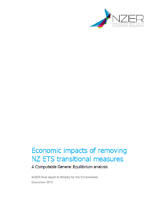This technical note sets out the results of macroeconomic modelling, by the New Zealand Institute of Economic Research, on the impacts of removing the New Zealand Emissions Trading Scheme (NZ ETS) one-for-two transitional measure at various carbon prices. The modelling was conducted using NZIER’s static computable general equilibrium model. This has been used to inform New Zealand’s climate policy in the past. Technical expertise and peer review was provided to NZIER by Infometrics.
This technical note sets out the results of macroeconomic modelling, by the New Zealand Institute of Economic Research, on the impacts of removing the New Zealand Emissions Trading Scheme (NZ ETS) one-for-two transitional measure at various carbon prices. The modelling was conducted using NZIER’s static computable general equilibrium model. This has been used to inform New Zealand’s climate policy in the past. Technical expertise and peer review was provided to NZIER by Infometrics.
This is one of three technical notes provided to support submissions for the NZ ETS review 2015/16 on the following priority issues:
- removing the one-for-two transitional measure
- managing the costs of removing the one-for-two transitional measure.
For the other two technical notes supporting priority issues see related publications below.
Submissions for Consultation for the NZ ETS review 2015/16 closed on 19 February 2016.
Important information on the technical note
This technical note shows the relative magnitude and direction of expected changes in the economy under different policy settings. It should not be used as absolute values. It is not a prediction of future New Zealand Unit prices or of the timing of potential policy changes and should not be used as such.
This modelling looks at the immediate impact of removing one-for-two and the effective doubling of carbon price for non-forestry participants. The possible secondary effect of price changes in response to altered supply and demand in the NZ ETS is not examined.
This modelling is not directly comparable with that released in setting New Zealand’s Intended Nationally Determined Contribution. This is because modelling the impact of removing the one-for-two measure is more specific and focuses on a near term change to the NZ ETS.
The computable general equilibrium modelling in this report is appropriate for macroeconomic effects. As the forestry sector is very significant and technically challenging to model in the NZ ETS, the Ministry for Primary Industries commissioned a separate technical note that focuses on the sector specifically, see Afforestation responses to carbon price changes and market certainties.
